 THE MONACO GRAND PRIX LIBRARY BY ROY HULSBERGEN THE MONACO GRAND PRIX LIBRARY BY ROY HULSBERGEN |
|


|
Mercedes-Benz |
|
|
One of the early drivers for Mercedes in the twenties was Alfred Neubauer, who very soon became the well known team manager for the make.
The early racing models were designed by Dr. Porsche.
In 1924 Mercedes won the Targa Florio, which was the beginning of a long list of victories with the young Caracciola.
In 1926 Neubauer invented the first signalisation system to communicate with drivers during a race.
In 1930 Daimler-Benz officially stopped racing as a result of the economic situation in the world.
A deal with Rudi Caracciola, who had to buy his own car, enabled a small Mercedes Team to continue racing and winning the Mille Miglia in 1931.
With the new FISA rules of 1932, the 750kg formula and the continuing bad economic situation, Mercedes retired from Grand Prix racing.
For the 1934 season, Daimler-Benz decided to build a new car for the 750kg formula, the silver arrow. At its first outing on the Nürburgring the car weighed one kg. too much. No part could be taken off and von Brauchitsch suggested to polish the white paint off and indeed the car lost the necessary kilo and thus had the silver shine of the polished aluminium and it won the race.
For the 1937 season, a young designer by the name of Dr. Uhlenhaut had come up with a revolutionary car. The resulting car was as comfortable as a club chair and featured 600 bhp or nearly 1bhp per kilo.
Uhlenhaut was a designer capable of driving the cars at competition speed and used his own driving experience in the design.
That same season Rudi Caracciola became European Champion for the second time with Mercedes.
In January 1938, the special Mercedes driven by Caracciola won the World Speed Record on a motor way at 280 miles per hour. The Mercedes Team started a GP driver school to discover new talent thus discovering Dick Seaman and Christian Kautz.
For the 1939 season Mercedes developed within 8 months a 12 cylinder 1500cc model, which won the GP of Tripoli, its first and last race. Hermann Lang became European Champion in Mercedes that year.
In 1950 Mercedes entered into racing again.
Two W125’s were still at the factory and two others were found in a scrap yard. With the four depleted cars they build two usable cars. Caracciola refused to drive the “old soapboxes” and Neubauer managed to engage Fangio for the GP of Argentina, but the cars were outdated.
Mercedes did not have the capital to design a new car for the coming season and decided to transform the 300SL into a GP car with wing doors, designed by Nallinger and Uhlenhaut.
This car came second in the Mille Miglia, took the first three places in the GP of Switzerland won the 24 hours of Le Mans followed by the Carrera Panamerica.
In 1954 Neubauer managed to put Fangio under contract, who became World Champion.
For 1955 the team’s acquisition was Stirling Moss. Moss could not beat Fangio, but won the Mille Miglia and the Irish Tourist Trophy.
At Le Mans after the catastrophic accident Mercedes retired their cars from the race.
After a double win of the Targa Florio, the Daimler Benz management decided on October 12th 1955 to retire from all racing events for economic and technical reasons.
GP’s contested: 12 from 1954 till 1955
Pole positions: 8
Victories: 9
Fastest lap: 9
|
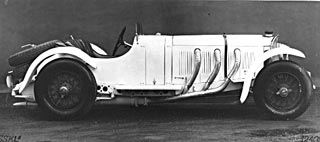
Early Mercedes SSKL
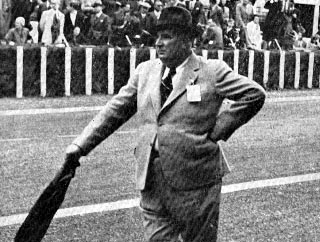
Alfred Neubauer on a circuit
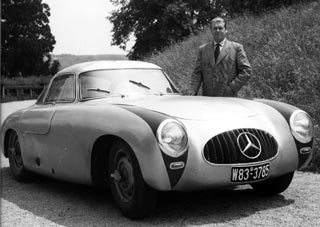
Dr. Uhlenhaut with a special 300SL
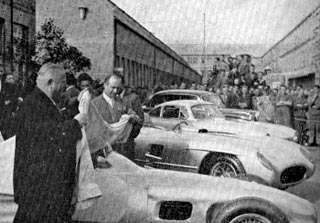
The last Mercedes racing cars with Fangio and Neubauer |
Mercedes-Benz SSK Type 720 - 1928
Chassis: channel section main chassis, longitudinal leaf spring suspension
Engine: 6 cylinder in line of 7069cc, 170hp or 225 hp with compressor at 3300 rpm. Top speed 192 km/H
Driver: Rudy Caracciola
|
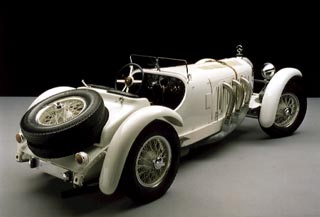 |
Mercedes-Benz SSKL - 1931
Chassis: channel section main chassis, longitudinal leaf spring suspension
Engine: Mercedes 6 cylinder in line of 7.1 litre giving 170/300 hp at 3500 rpm, top speed 210 km/h
Driver: Rudy Caracciola
Results: ‘31: 1st Germany
Mercedes-Benz retired from competition in 1932 |
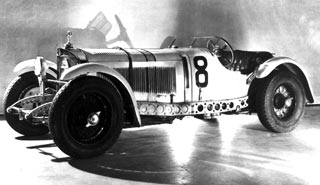 |
Mercedes-Benz W25 - 1934
Chassis: tubular space frame with independent suspension, designed by Dr. Porsche
Engine: Mercedes 8 cylinder in line of 3364cc giving 354 hp
at 5800 rpm, top speed 280 km/h
Drivers: Luigi Fagioli, Manfred von Brauchitsch, Rudi Caracciola, Louis Chiron
Results: 1934: 1st GP Germany, 1935: 1st Monaco + 5 GP’s, 1936: 1st Monaco, Germany, Tripoli, Italy, Switzerland |
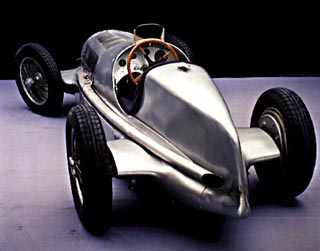 |
Mercedes-Benz W125 - 1937
To face the challenge from the new cars of Auto Union and Alfa Romeo the Mercedes factory decided to construct a new 600bhp 5.6-litre V12 for the 1936 season. When the first engine was assembled during the summer of 1935, it proved to be seriously overweight (295 kg against 185 kg for the old engine). To fit this heavy engine into the cars under the 750 kg limit demanded considerable changes to be done to the 1936 cars to save 110 kg of weight. Mercedes-Benz made the radical decision to cut off 25cm from the wheelbase of their GP car. Other new parts in the car included a transverse gearbox and a de Dion rear axle. The new car was in fact so small that the tall von Brauchitsch could not fit into it properly. Somehow the engineers managed to squeeze the engine in under the weight limit only to find that the weight distribution was such that the car was totally undrivable.
Chassis: tubular space frame with independent suspension, designed by Dr. Uhlenhaut
Engine: Mercedes 8 cylinder in line of 5663cc giving 646 hp
at 5800 rpm, top speed 330 km/h.
Drivers: Louis Chiron, Rudy Caracciola, Manfred von Brauchitsch, Hermann Lang, Dick Seaman
Results: ‘37: 1st Monaco, Germany, UK Switzerland, Tripoli, ‘38: 1st GP Germany, Switzerland, 3rd UK,‘39: 1st GP Tripoli, Eiffel, Vienna, Belgium, Germany, Switzerland |
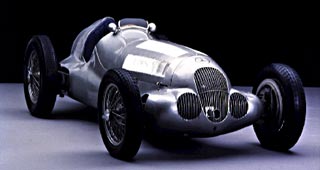 |
Mercedes W196 - 1954
Chassis: tubular space frame with independent suspension with low pivot swing axles in the rear and inboard brakes. Initially with full body (Stromlinienwagen) but quickly adapted to open wheel bodies. For 1955 a short version was made with outboard brakes.
Engine: In line 8 cyl with direct fuel injection and desmodromic valve operation. Initially delivering 257 hp and later upgraded to 290 hp.
Drivers: Juan Manuel Fangio, Hans Herrmann, Karl Kling, Hermann Lang, Stirling Moss, André Simon, Piero Taruffi
Results: ‘54: 1st France, UK, Germany, Switzerland, Italy, ‘55: 1st Argentina, Belgium, Holland, UK, Italy. Fangio in both ‘54 and ‘55 World Champion.


|
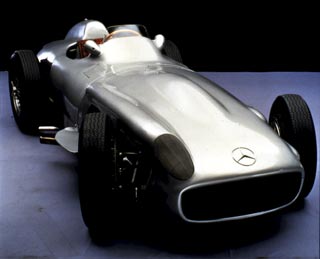
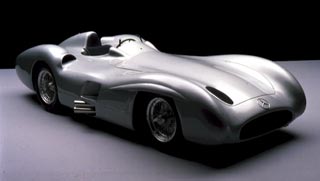
Photos courtesy Mercedes-Benz Museum |

|
 THE MONACO GRAND PRIX LIBRARY BY ROY HULSBERGEN
THE MONACO GRAND PRIX LIBRARY BY ROY HULSBERGEN










